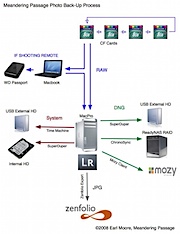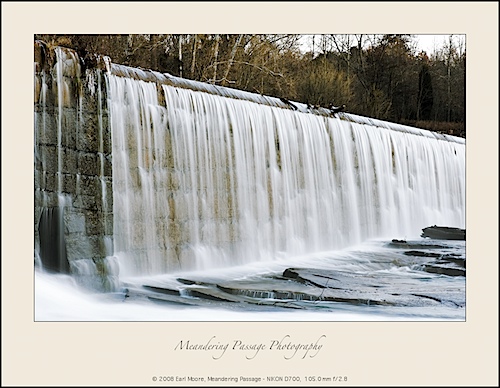I now shoot exclusively in RAW format and then convert the RAW files into DNG files when importing into Adobe Lightroom. My back-up process (see section below) doesn’t include any long term saving of the original RAW files.
I’m curious if others would recommend saving the original RAW files and why?
What would be an occasion where I might need one of those RAW files over my DNG copy?
Note, I always do non-destructive editing and retain a copy of the unchanged DNG file.
 MP Photo Back-up Process (click on diagram for large image)
MP Photo Back-up Process (click on diagram for large image)
1. CF memory card rotation. I rotate through my CF memory cards only formating them as I put them in the camera. Older photos are preserved on the CF cards until the next use.
2. Importing: If I’m shooting locally I’ll import my photos into Adobe Lightroom directly from the CF card. However, if I’m in a remote location I’ll save copies of photos from the CF card onto my MacBook and a Western Digital Passport hard drive which can be later imported into Lightroom. All RAW files are converted to DNG files upon import.
3. System: I use an Apple Mac Pro computer as my main computer. The system and user documents are backed up by two different methods on two different drives.
Method One uses Apples Time Machine back-up application to back up to an external Samsung 500Gb USB drive. This method allows version restoring of individual documents based upon saved dates. Documents and or applications can be restored from 6-9 months of back-up history. Time Machine back-ups run every 4 hours.
Method Two uses SuperDuper to make a duplicate of the main boot drive on the Mac Pro to another internal Mac Pro hard drive. This back-up also includes all applications and documents. This back-up takes about 30 minutes and is run each night, every 24-hours If the main boot drive fails I can quickly switch over to booting from this drive while I replace the failed one. (I’m considering using OS X to set-up a software Raid 1 between this drive and the boot drive.)
4. DNG/Photo Files: These are my main photo files and I back them up by three different methods.
Method One: Using SuperDuper to back up all photo files and the Lightroom Db each night to an external USB hard drive.
Method Two: Using ChronoSync to synchronize my internal photo hard drive with a NAS (Network Access Storage) Raid 5 device each night via my home network. This device allows me to share my photos with other computers on my home network without sharing my main drive. This NAS back-up also retains different versions of files as well as the Lightroom Db. With RAID 5 if one device HD fails I just swap in a new one and it keeps running while it rebuilds the new drive.
Method Three: Using the Internet back-up service Mozy all my photo files and my Lightroom database is back-up off site over the Internet. This is a very slow process but one that once set up you can forget about and let run automatically. If doing a large number of new photos it may take days or even weeks to get them all fully back-up but then it only backs up the changed ones. With unlimited storage only costing $4.95 per month it’s affordable and for me the Mozy Mac client seems to work.
5. JPG Backup: This is an extra back-up step that doesn’t cost me anything extra except a little time and it does provide JPG files of all my photos that can be shared from anywhere. I use Zenfolio as my photo gallery and for the $40 per year fee you get unlimited storage. Jeffrey Friedl’s Lightroom Zenfolio Export Plug-in can be set-up to upload a JPG copy of all photos to Zenfolio. Instruction for doing this as a back-up can be found here.
Discover more from Meandering Passage
Subscribe to get the latest posts sent to your email.


Making RAW photography future proof is a complicated issue for which I do not have a satisfactory solution. Some considerations to take into account when designing a backup strategy might include:
* almost all existing raw formats at the moment can be decoded with the existing and continuously developed dcraw utility. As long as this program exists and a processor architecture where it can be executed, it should always be possible to convert a raw file into a 16bit tif, which then would form the basis for further work on the file in an image editor.
* at the moment all major raw converters (and also dcraw) support the dng format, and I see this as a major advantage. However nobody can make predictions about the future existence of those companies and, their code being proprietary, these programs can not be considered a future proof solution.
* dng files in most cases can not be opened by the camera manufacturers proprietary programs, which are in some cases the only programs that can make use of informations encrypted in the original raw files. That this practice is bad and should be banned is true, but we still have to deal with it.
* as the dng is by use of lossless compression at least 30% smaller than the raw file, it looks like there is only one single drawback, and this is the loss of encrypted information. If storage space is without price, the option would be do include the original raw file into the dng, to play double safe.
At the moment in my eyes it looks as if there is no major drawback in using dng, and you win some storage space. Additionally it can be seen as a signal to camera and software makers that dng should be the way to go.
@Markus: Thank you for sharing your thoughts on RAW. You bring up some good points and I agree there needs to be greater support for the DNG format from both camera manufacturers and their proprietary editing software. I appreciate your input.
You have a backup strategy of which most photogs would be envious (not in equipment, per se, but rather thoroughness).
If storage were a complete non-issue, saving the RAW files would be a prudent thing to do. And though people talk about storage being cheap, as you are probably aware (judging from your excellent multi-contingency backup solution) it is not without cost and/or effort. And the file sizes are getting bigger and bigger. I think you stand a better chance of being able to open a DNG file 10 years from now with an average computer setup than a proprietary RAW file. And I’m hard-pressed to think of anything that the RAW would possibly give you as far as re-tweaking the original exposure again. The only advantage I can imagine is that some RAW converter/developer that would be compensating for the lens/sensor combo a ‘la DXO. You could do that on the DNG file, of course, but the software might not “recognize” the DNG file easily (is all the EXIF info copied exactly?) But that scenario seems unlikely, since camera makers don’t really support their digital models that long before the next big thing comes out.
Personally, I’d just save the DNG files. I worry for photographers who DON’T save anything but the RAWs. My GX100 produces DNG files straight out of the camera, for which I am grateful.
@Eric: You pretty much outlined my own thinking on the subject. I’m playing the odds that DNG will be more future proof then Proprietary RAW files. I’ve yet to experience a need for a RAW file that DNG hasn’t satisfied.
I didn’t realize the Ricoh GX100 supported DNG output…that’s excellent! I wish more manufactures would give DNG as an output file option! Perhaps some day.
Thanks for sharing and confirming much of my own thinking.
If you want to be safe, save the RAW file, save a TIFF, and make a print. It sounds extreme perhaps, but I personally feel weird about DNG. I realize some manufacturers have gotten into bed with Adobe, so to speak, and offer DNG on their cameras, but Canon and Nikon have been around a lot longer than Adobe, and I don’t like the idea that in the future I will be locked into using Adobe based software to open my RAW files. People whine about camera manufaturers having proprietary formats and not “sharing” their RAW details with Adobe, but let’s remember that Adobe certainly does NOT allow third party companies to use facets of Photoshop in their softwares. Adobe is one of the worst for being “anti-open source” with regards to their products.